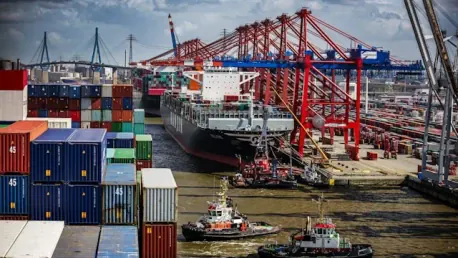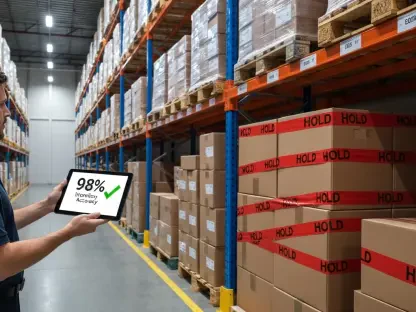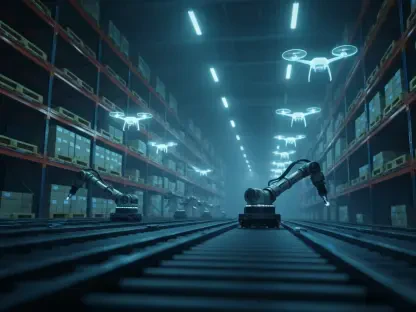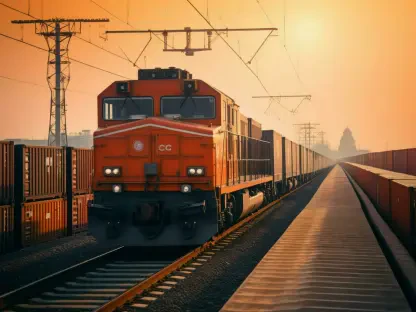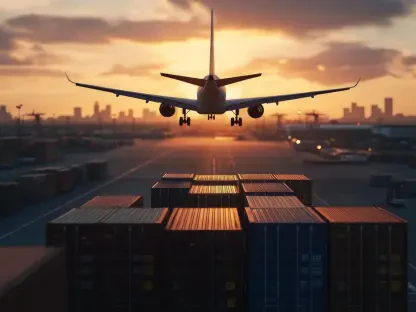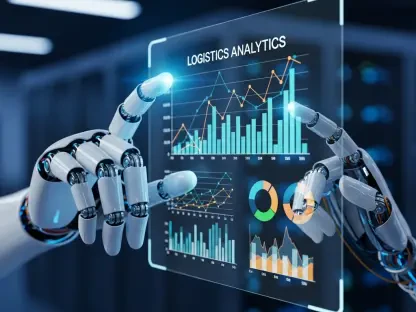The freight and logistics industry stands on the brink of a transformative era, spearheaded by the unprecedented integration of artificial intelligence (AI) and automation. These advancements promise to rewire the circuitry of an industry that’s been historically reliant on manual oversight and human effort. This article delves into how AI and automation are redefining freight and logistics, enhancing efficiencies, productivity, and operational outcomes.
Artificial Intelligence in Route Optimization and Demand Forecasting
AI-Driven Route Planning
AI has revolutionized route planning, a crucial element in logistics. Traditional route planning often involved laborious manual calculations and estimations, but AI brings a level of precision and flexibility that significantly reduces fuel costs and delivery times. Machine learning algorithms analyze myriad data points—traffic conditions, weather forecasts, and even social events—to find the most efficient paths for shipments. This optimization not only conserves time and fuel but also reduces the carbon footprint of logistics operations.
Additionally, by continuously learning and updating, AI-driven route planning systems adapt to changes in real-time, ensuring that logistics operations are as efficient as possible. This capability has profound implications for an industry where timely deliveries are crucial. Businesses can now reroute shipments on the fly, avoiding delays caused by unexpected roadblocks, accidents, or adverse weather conditions. Moreover, this intelligent route optimization allows companies to maximize the utility of their transportation assets, thereby reducing idle times and improving overall fleet management.
Predictive Demand Forecasting
Another noteworthy application is predictive demand forecasting. Conventional methods relied on historical data and linear regression models, but AI examines complex patterns in real-time data to predict future demands with startling accuracy. Businesses can now manage their inventory levels better, avoiding both overstocking and understocking issues. This capability diminishes waste and ensures that customer needs are met promptly, bolstering customer satisfaction and operational efficiency.
Predictive demand forecasting through AI also allows companies to be more responsive to market fluctuations, seasons, and consumer behavior. For example, machine learning models can analyze trends from social media, news, and even search engine queries to anticipate spikes in demand. This proactive approach means that businesses can prepare for high-demand periods, such as holidays or special promotions, by adjusting their inventory and staffing levels accordingly. This not only reduces the risk of stockouts but also improves cash flow management by preventing unnecessary overproduction. Consequently, businesses can operate with greater agility and responsiveness, a key competitive advantage in today’s fast-paced market environment.
Addressing Labor Shortages with Automation
Alleviating Labor Gaps
The logistics industry faces a significant labor shortage, with a dire prediction of 1.7 million job openings in the U.S. alone in the near future. Automation presents a viable solution to this predicament. Automated systems can take over repetitive and mundane tasks, such as paperwork, package sorting, and basic maintenance, thereby freeing human workers for more complex roles that necessitate decision-making and oversight.
Automation can also mitigate the effects of high employee turnover rates, a common issue in the logistics sector. By deploying automated systems, companies can maintain operational consistency even when faced with staffing gaps. This reduces downtime and ensures that the supply chain remains uninterrupted. Additionally, automation can be upscaled without the significant time and resources required to recruit, train, and retain new employees. This scalability is crucial for logistics operations that need to ramp up capacities quickly in response to market demands or seasonal spikes.
Enhancing Worker Safety and Productivity
Furthermore, automation enhances worker safety and productivity. With machines taking on dangerous tasks like lifting heavy goods or handling hazardous materials, the risk of workplace injuries decreases dramatically. Automation tools also enable workers to focus on more value-driven tasks, elevating overall job satisfaction and productivity.
Automated machinery can also perform tasks with a level of precision that reduces human error, leading to fewer mistakes and less waste. For example, robots used in packaging and labeling ensure that products are consistently handled with care, reducing damage rates and improving product quality. In turn, this boosts customer satisfaction and loyalty, which are critical for long-term business success. By improving the safety and efficiency of the work environment, companies can foster a more motivated and engaged workforce, further driving productivity and innovation.
The Rise of Autonomous Trucking
Projected Timeline and Benefits
Autonomous trucking is no longer a futuristic concept; it’s anticipated to be operational within four to seven years. The most compelling advantage of self-driving trucks is the ability to operate without the need for human breaks, substantially cutting down on transit times. These trucks can function around the clock, creating a seamless and uninterrupted supply chain.
Autonomous trucks are equipped with advanced sensors and AI systems that enable them to navigate complex road conditions, avoid obstacles, and adhere to traffic laws. This level of automation leads to more consistent driving patterns, reducing wear and tear on vehicles and extending their lifespan. Additionally, the cost savings associated with reduced labor requirements and fuel efficiency can be substantial, offering companies a significant return on investment. By eliminating human fatigue and error, autonomous trucks can also enhance road safety, potentially reducing the number of accidents caused by driver negligence or exhaustion.
Regulatory and Safety Challenges
However, the road to autonomous trucking isn’t without its bumps. Regulatory hurdles, such as those illustrated by California’s Assembly Bill 316, present challenges. These regulations mandate stringent safety protocols for autonomous vehicles, intending to prevent accidents involving driverless trucks. Overcoming these regulatory obstacles will be crucial to the widespread adoption of autonomous trucking.
To address these challenges, industry stakeholders are actively collaborating with regulatory bodies to develop frameworks that ensure safety without stifling innovation. Pilot programs and controlled testing environments are instrumental in demonstrating the reliability and safety of autonomous trucking technology. Additionally, continuous advancements in AI and sensor technology are making these systems more robust, capable of handling an ever-wider range of scenarios. As these technologies mature and regulatory frameworks become more accommodating, the transition to autonomous trucking could usher in a new era of logistics efficiency and safety.
Automating Intermodal Transportation
Integration of AI with Trains
Intermodal transportation, which combines trains and trucks, stands to gain significantly from AI and automation. While fully autonomous freight trains are unlikely due to the high risk of transporting hazardous materials, there are still noteworthy advancements. AI technologies are being applied to optimize individual shipping containers and enhance terminal productivity.
By automating aspects of container management, such as tracking, stacking, and routing, AI can streamline the entire intermodal process. For example, sensors and smart tags on shipping containers provide real-time data on their location, condition, and security. This information is analyzed by AI algorithms to optimize loading and unloading sequences, reducing turnaround times at terminals. These systems also improve the coordination between different transportation modes, ensuring that goods move seamlessly from trains to trucks and vice versa. The cumulative effect is a more efficient and reliable supply chain that can quickly adapt to changing demands.
Improved Efficiency and Sustainability
These technologies contribute to more efficient loading and unloading processes, improved product safety, and better overall efficiency. Additionally, intermodal transportation’s use of trains, which are more fuel-efficient than trucks, already offers an environmentally friendly alternative. AI enhances these benefits by coordinating logistics more precisely and reducing energy consumption.
The environmental advantages of intermodal transportation are further amplified by the use of AI to optimize fuel consumption and minimize idle times. Predictive maintenance, powered by AI, ensures that trains and trucks are serviced just in time to avoid breakdowns and inefficiencies. This not only extends the life of transportation assets but also reduces the carbon footprint. By leveraging these technologies, companies can achieve significant cost savings while also meeting increasingly stringent environmental regulations. The integration of AI and automation in intermodal transportation represents a critical step towards a more sustainable and efficient logistics ecosystem.
Warehouse Automation: The Future of Fulfillment Centers
Surge in Robotics
Warehouse automation is experiencing a significant upsurge, with robot shipments projected to rise by 50% annually until 2030. Innovations such as robotic arms capable of intricate tasks like picking and packing products are transforming warehouse operations. These robots operate with a level of speed and accuracy that is unattainable by human workers, thereby reducing human error and increasing output.
As a result, companies can process more orders in less time, meeting the growing demand for rapid fulfillment driven by e-commerce. Automated guided vehicles (AGVs) and autonomous mobile robots (AMRs) are also becoming increasingly common in warehouses, navigating aisles and transporting goods with minimal human intervention. This integration of robotics not only boosts operational efficiency but also allows for greater scalability. Warehouses can easily adjust to fluctuations in demand by simply reprogramming the robots for different tasks, avoiding the complexities and costs associated with hiring and training temporary staff.
AI-Driven Inventory Management
Moreover, AI-integrated inventory management systems provide real-time insights into stock levels, demand fluctuations, and supply chain bottlenecks. This predictive capability ensures that warehouses can operate at optimal efficiency, minimizing downtime and enhancing resource allocation. The technology also improves worker safety by taking over hazardous or physically demanding tasks, making warehouses safer and more efficient workplaces.
These advanced inventory management systems use machine learning algorithms to forecast demand and automatically adjust inventory levels, ensuring that stock is replenished just in time. This reduces the carrying costs associated with excess inventory and minimizes the risk of stockouts. Furthermore, AI systems can identify patterns and anomalies in the supply chain, allowing managers to proactively address potential issues before they escalate. This level of insight and control enables warehouses to operate more smoothly and respond swiftly to market changes, ensuring that customer expectations are consistently met.
Navigating Disruptions with AI
Adaptive Response to Crisis
AI plays a pivotal role in managing disruptions, be it natural disasters or geopolitical events. For instance, during the Red Sea attack, AI enabled businesses to swiftly adjust shipment volumes and shift logistics modes. Predictive analytics allowed companies to anticipate the ripple effects of the disruption and reconfigure their operational strategies accordingly.
By leveraging AI, companies can run multiple scenarios to determine the best course of action in response to a disruption. This enables them to mitigate risks and minimize losses, maintaining service continuity even under challenging conditions. AI can also integrate various data sources, such as satellite imagery, weather forecasts, and political news, to provide a comprehensive situational awareness. This holistic view allows companies to make informed decisions quickly, reducing the impact of disruptions on their supply chains and maintaining a competitive edge.
Identifying Opportunities Amidst Challenges
AI not only helps in crisis management but also in identifying new opportunities amid disruptions. By analyzing historical market reactions to similar events, AI provides actionable insights that help businesses pivot their strategies. This adaptability ensures that logistics operations remain resilient and responsive, maintaining service quality even during crises.
For example, during unforeseen events that disrupt normal shipping routes, AI can identify alternative routes or modes of transportation that can be leveraged to maintain supply chain continuity. Additionally, AI-driven market analysis can reveal emerging trends and shifts in consumer behavior, allowing companies to capitalize on new opportunities. Whether it’s adjusting product offerings, entering new markets, or reconfiguring logistics networks, AI provides the tools needed to turn challenges into opportunities. This proactive approach ensures that companies are not only prepared for disruptions but are also positioned to thrive in their aftermath.
Consensus and Future Outlook
The freight and logistics industry is on the verge of a revolutionary transformation, driven by the groundbreaking integration of artificial intelligence (AI) and automation. Historically, this sector has relied heavily on manual oversight, human labor, and traditional methods. However, AI and automation technologies are now poised to fundamentally alter its landscape. By intelligently managing tasks, optimizing routes, predicting maintenance, and enhancing real-time decision-making, these advancements are set to significantly boost efficiencies and productivity.
AI algorithms can analyze vast amounts of data to streamline operations and enhance supply chain visibility. For instance, predictive analytics can forecast demand more accurately, allowing for better inventory management and reducing costs. Automation, on the other hand, can handle repetitive tasks like sorting and scheduling, freeing up human workers for more complex, strategic roles. This can lead to more efficient warehouse management and faster shipping times.
In addition to operational efficiencies, AI and automation can also improve safety standards within the industry. Automated systems are less prone to human error, and AI can predict potential issues before they become significant problems, thereby preventing accidents and downtime. Ultimately, integrating AI and automation into freight and logistics not only promises more efficient and productive operations but also paves the way for a safer, more reliable supply chain.
